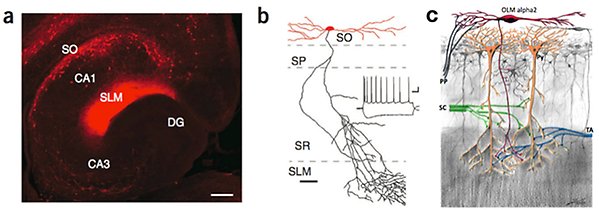OLMα2 cells in hippocampal circuits of learning
Hippocampal neurocircuitries are involved in spatial navigation as well as memory formation and are of relevance to loss of cognitive abilities in for example Alzheimer’s disease. Hippocampal interneurons are a diverse population of cell types, which have distinct post-synaptic domains and differentially control input/output activity, however, the precise roles played by the distinct inhibitory cell types remain poorly defined. Recent experiments suggest that control of pyramidal cell activity by GABAergic interneurons is critical for the execution of hippocampal functions.
Oriens lacunosum-moleculare (OLM) cells have been hypothesized to coordinate cell assemblies, to produce theta oscillations, and gating of long-term potentiation. However, the specific function of OLM cells has not been directly demonstrated. We previously reported that Chrna2 is a marker for a subset of OLM cells (OLMα2), a major class of GABAergic interneurons in the outermost layer of the hippocampus (Leao et al., Nature Neuroscience 2012, 15:1524-30).
OLMα2 cells inhibit the distal apical dendrites of PCs in CA1, the same cellular compartment where the direct input originating from layer III of the entorhinal cortex arrives, forming the temporoammonic pathway. Our in vitro results suggest that OLMα2 cells act as gatekeepers, providing a tentative mechanism for how the flow of information is controlled in the hippocampus.
OLM alpha 2 associated with risk-taking behaviour
OLMα2 cells inhibit distal portions of CA1 pyramidal cell dendrites while disinhibiting proximal dendrites and can thereby modulate synaptic efficiency and plasticity of entorhinal cortex and CA3 inputs. In our in vivo experiments, we found that optogenetic activation of OLMα2 interneurons in the ventral hippocampus drives type 2 theta oscillations and was associated with increased risk-taking behaviour in response to predator odour. Further, we found that two theta oscillations subtypes originate in the dorsal and ventral hippocampus and predominantly underlie either cognitive or emotion-related functions (Mikulovic et al., 2018, Nature Comm, 9:3638. doi: 10.1038/s41467-018-05907-w).
In another set of experiments, we used channelrhodopsin or archaerhodopsin in Chrna2-cre mice to test the presumable role of OLMα2 cells as gatekeepers in memory and learning. Light modulation of OLMα2 cells in the object recognition test suggest that activation of OLMα2 cells hampers learning while inactivation improves learning (Siwani et al., 2018, Neuron 99:404-412). These studies continue where miniscope recordings during behaviour are underway to reveal pyramidal cell activity upon OLM cell modulation.

OLM cells are recognized by their expression of the nicotinergic receptor alpha2. a) A Chrna2-cre/tomato mouse demonstrating cells labelled in the stratum oriens (SO) and their dense projections in the stratum lacunosum moleculare (SLM). b) A camera lucida reconstruction of a single OLM cell. c) Position of an OLM cell relative to the pyramidal cells (Py), inputs from the perforant path (PP), Schaffer collaterals (SC) and temperoammonic pathway (TA).
